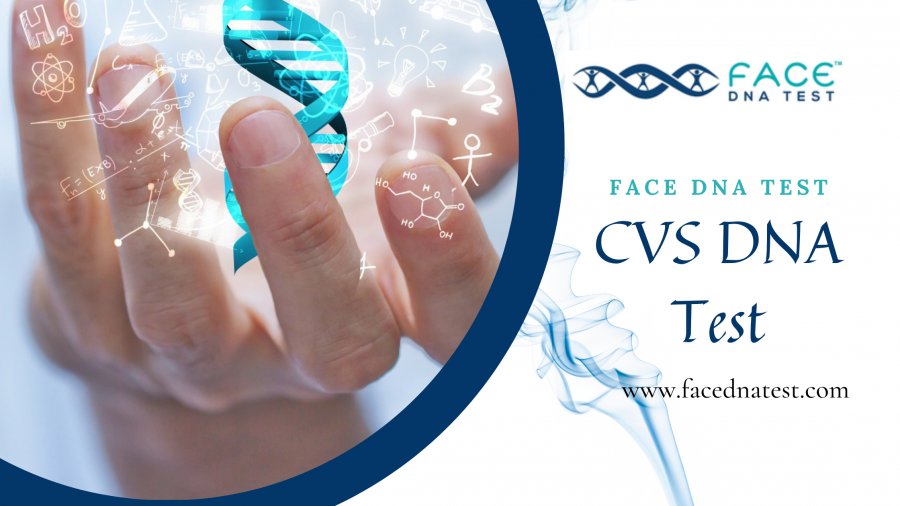CVS DNA Test is usually performed between 10 and 12 weeks of gestation period. Unlike amniocentesis, this test does not give information on neural tube defects, such as the “spina bifida” condition. Because of this, women who choose the CVS technique are also required to have a follow-up blood test which is done between the 16th and 18th weeks of pregnancy to screen for neural tube defects.

There are two types of CVS procedures:
- Transcervical– it is done by inserting a catheter through the cervix into the placenta to get the tissue sample.
- Transabdominal– in this case, the tissue sample is obtained by inserting the needle through the abdomen and uterus into the placenta.
Generally, a CVS procedure follows this process:
- First, your vital signs (heart rate, breathing rate, and blood pressure) will be checked.
- After checking the main signs, an ultrasound will be done to check the fetal heart rate, and the position of the fetus, placenta, and umbilical cord.
Based on the location of the placenta, the CVS procedure will be performed by transcervical process or transabdominal process.

In a transabdominal procedure, it is important to check the bandaged needle site on your abdomen for any bleeding or drainage of fluid. Take assistance from the “facednatest” professionals, who will also you additional or alternate instructions after the procedure, depending on your particular situation.
You can also find services in your region by searching like that “DNA testing near me”, which will give you numerous good options in DNA testing.
How is chorionic villus sampling done?
A technique called chorionic villus sampling (CVS) is carried out during the gestation period in order to find genetic defects in the fetus. A little specimen of chorionic villi is collected during CVS by inserting a tiny tube into the cervical cavity or a needle via the belly. Small, finger-like tissue fragments eventually form the placenta called chorionic villi, which are linked to the uterine wall. The placenta is located during the process, usually carried out around weeks ten and thirteen of fetal development under ultrasound supervision. Following collection, the sample is submitted to a laboratory for genetic and chromosomal analysis.
What is a CVS procedure and complications?
Chorionic villus sampling is known as CVS. This prenatal test involves removing a tiny sample of tissue called the chorionic villi from the placenta and examining it for chromosomal anomalies and genetic illnesses. It is usually carried out during weeks ten and thirteen of gestation. The chorionic villi, which resemble tiny fingers of placental tissue, are made of the same genetic material as the developing fetus. Testing for further genetic abnormalities and illnesses could be possible.
A tiny hollow tube or syringe is inserted to collect the biopsy specimen, the cervical cavity is dilated, and the genital area is cleaned and sterilized as part of the CVS procedure. The quantity gathered is comparable in size to a single grain of rice. The process takes ten to fifteen minutes. It’s normal to have some cramps during and following the procedure. Miscarriage, infection, and surgically caused limb decrease abnormalities are among the risks. When a skilled physician performs cardiovascular surgery, the chance of miscarriage is lower than one percent.
What does chorionic villus sampling test for?
Numerous chromosomal defects and genetic illnesses, including the genetic disorder Down syndrome, Tay-Sachs condition, sickle cell disease, a condition called cystic fibrosis, and genetic problems, including Turner syndrome, are conditions that CVS can test. Many disorders can be diagnosed using this procedure. A primary benefit of chorionic villus sampling over amniocentesis is its ability to be performed during weeks ten and thirteen of gestation. In contrast, amniocentesis is only performed between weeks 14 and 22 of pregnancy. Since chorionic villi cells divide more quickly than amniotic fluid cells, CVS findings are obtained sooner.
What is one advantage of chorionic villus sampling over amniocentesis?
While amniocentesis is carried out around 15-20 weeks of pregnancy, the main benefit of chorionic villus sampling (CVS) is that it may be conducted between 10 and 13 weeks of pregnancy. If a chromosomal anomaly is found, this allows parents additional time to make options.
In contrast with 2nd-trimester amniocentesis, CVS carries a greater chance of miscarriage; however, it can yield results before the end of the first trimester. CVS is performed via the abdomen with the use of ultrasound imaging. During amniocentesis, amniotic fluid is extracted by passing a tiny needle through the abdomen.
Choose Clarity with Our DNA Test.
Get Accurate Answers With our Test!.
-
- Accurate
- Quick Result
- Private and Secure
- Affordable

Conclusion
Face DNA Test offers the most up-to-date advanced screening for pregnant moms, ranging from noninvasive Face DNA test alternatives to intrusive CVS procedures. Make an appointment for a genetic consultation to ascertain the most appropriate test for your pregnancy, threats, and preferences. Face DNA testing can relieve your concerns.
CVS may be performed early and yield faster results despite certain dangers, such as miscarriage. Consultation with a medical specialist regarding chorionic villus sampling might assist pregnant parents worried about inheritance issues in assessing whether it is a suitable procedure. More details on the CVS procedure, costs, and if it might be advantageous for you to use during pregnancy are available from the professionals at Face DNA Test.







Leave a Reply
Your email is safe with us.
You must be logged in to post a comment.